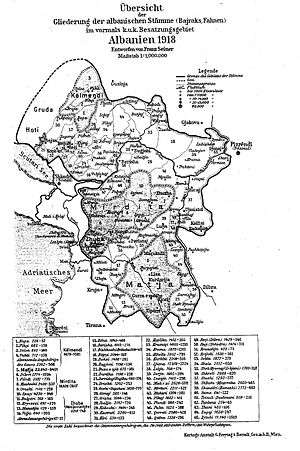Krasniq
Coordinates: 42°11′N 20°18′E / 42.183°N 20.300°E

Krasniq (also Krasniqi or Krasniqja) is a mountainous region (krahinë) of the Prokletije range in northeastern Albania, bordering Kosovo[1] whose territory is synonymous with the historic Albanian tribe of the same name. The region lies within the Tropojë District, historically known as Malësia e Gjakovës and stretches from the Valbonë river in the north to Lake Fierza in the south, and includes Bajram Curri. Members of Krasniqi tribe are also found in Kosovo.
Geography
The Krasniqi region is situated in the District of Tropoja north of the Drin River, from Fierza east to the District of Has, and north to the Montenegrin border, including most of the upper Valbona valley.
It borders on the traditional tribal regions of Nikaj-Mërtur to the west, Bugjoni to the south, Bytyçi to the east, and Gashi to the northeast.
History

The name, was recorded in 1634 as Crastenigeia.[2]
There exist differing views on the origin of the tribe.
- According to Robert Elsie and Edith Durham, the tribe was originally Albanian and Roman Catholic, and had converted into Islam during the Ottoman period.[2][3]
- According to Serbian sources the tribe was originally Serbian (Slavic), Orthodox, and had by 1692, during Ottoman atrocities, converted into Islam, after which it became Albanianized.[4][5] In Serbian, the tribe is known as Krasnići (Краснићи) and Krastenići (Крастенићи).
It is a historical bajrak, which together with Gashi, Bytyçi and Nikaj-Mërtur constituted the Malësia e Gjakovës ("Mountains of Gjakova").[6] In a narrower sense, the Gjakova highlands include the Krasniq, Bytyç and Gash.[7] In Albanian ethnographical studies, the Gjakova Highlands include Krasniq, Gash and Bytyç.[8]
Beside the historical habitat, most of the Krasniqi fis (clan) are located in Kosovo, especially in the western part, having settled there since 18th century.[9]
Ethnography
The region is inhabited by Muslims; the tribe converted from Christianity into Islam in the Ottoman period.
The tribe's (historical) patron saint is St. George,[10] whom they still revere after Islamization.[11]
According to mythology, the Krasniqi descend from a Kolë Mekshi,[12] a brother to the founders of the Serb (Slavic) tribes of Vasojevići, Piperi, Ozrinići and the Albanian tribe of Hoti, respectively.[13] The Krasniqi revere their mythological kinship especially to the Vasojevići,[14] an Orthodox Serb tribe in eastern Montenegro.
Krasniqi in the Republic of Macedonia
On the Kumanovo Black Mountain, Albanians of the Krasniqi fis were present in the villages of Gošince, Slupčane, Alaševce (in Lipkovo) and Ruđince (in Staro Nagoričane), according to a 1965 journal.[15]
Notable people
- Bajram Curri, with family roots from Nikaj tribe, Albanian revivalist, born in Krasniq
- Rexhep Krasniqi, Albanian MP, Minister of Education, and anti-communist
- Binak Alia, from Mulosmanaj clan of Krasniqi, guerrilla fighter of the Albanian Revolt of 1845 and League of Prizren
- Mic Sokoli, Guerrilla fighter
- Haxhi Zeka, Member of the League of Prizren
- Behgjet Pacolli, a former President of the Republic of Kosovo and is the President and CEO of Mabetex Group, a Swiss-based construction and civil-engineering company.
See also
- List of Albanian tribes
- Krasniqi, surname
References
- ↑ Arshi Pipa (1978), Albanian folk verse: structure and genre, Volumes 17-19, Trofenik, p. 126
- 1 2 Robert Elsie (2010), Historical Dictionary of Albania (PDF), Historical Dictionaries of Europe, 75 (2 ed.), Scarecrow Press, p. 248, ISBN 978-0810861886, archived from the original (PDF) on 2014-10-06
- ↑ The Tribes of Albania,: History, Culture and Society. Robert Elsie. p. 161.
- ↑ Никола Чупић (1907). Годишњица Николе Чупића. 26. Штампа Државне штампарије Краљевине Југославије. p. 187.
- ↑ Kosto Kulišić (1912). Put rusa Aleks. Bašmakova preko Crne Gore i kroz zemlje Gega. Štamparija deoničarskog društva branika. p. 36.
- ↑ La Ricerca folklorica. Grafo edizioni. 1998. p. 64.
Krasniqe, Gashi, Bytyci, Ni- kaj-Merturi, Berisha, dans la Montagne de Gjakova
- ↑ Great Britain. Foreign Office. Historical Section (1920). Albania. H.M. Stationery Office. p. 15.
- ↑ Kultura popullore. Akademia e Shkencave e RSH, Instituti i Kulturës Popullore. 1992. p. 34.
Nga pikëpamja etnografike, Malësia e Gjakovës përbëhet nga Bytyçi, Gashi, Krasniqja dhe Berisha
- ↑ Karl Kaser (2012), Household and Family in the Balkans: Two Decades of Historical Family Research at University of Graz, Studies on South East Europe, 13, LIT Verlag, p. 124, ISBN 978-3643504067
- ↑ Mitološki zbornik. 12. Centar za mitološki studije Srbije. 2004. p. 41.
- ↑ Srpska akademija nauka i umetnosti (1957). Posebna izdanja. 270. p. 24.
Исламизо- вани Арбанаси Краснићи и сада поштују св.
- ↑ The Tribes of Albania:History, Society and Culture. Robert Elsie. p. 162.
- ↑ Vasa Čubrilović (1983). Odabrani istorijski radovi. Narodna knjiga. p. 380.
- ↑ Henry Baerlein (1922). A Difficult Frontier (Yugoslavs and Albanians). L. Parsons. p. 71.
- ↑ Naučno društvo Bosne i Hercegovine: Odjeljenje istorisko-filoloških nauka. 26. 1965. p. 199.
Arbanasa fisa Krasnića ima u selima: Gošnicu, Slupćanu, Alaševcu, Ruđincu.